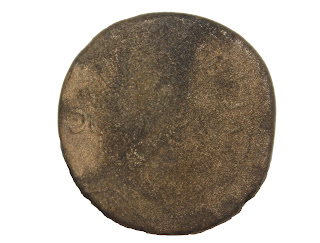The hot springs at Bath were not just used for bathing by the Romans; they often threw objects into the Sacred Spring as offerings to the goddess. The most common of these offerings were coins, with nearly 13,000 having been recovered during excavation. These coins were deposited from the early years of the sanctuary through to the early fifth century at the end of the Roman province. The majority are small change, however there are a small number of silver coins and four gold coins. In today’s blog post, we are going to look at a coin produced during Septimius Severus’ reign.
 |
| Denarius of Septimius Severus, obverse (l) and reverse (r) |
Born in Leptis Magna, modern day Libya, Septimius Severus was the first African-born Roman emperor. His predecessor, Pertinax, was murdered by the Praetorian Guard. Following his proclamation as emperor, Severus declared himself as the avenger of Pertinax and marched on Rome. During his reign, Severus debased the Roman currency by decreasing the silver purity of the denarius. This was the largest act of debasement since Nero and compromised the long-term strength of the economy. His reign was also characterised by military campaigns in both Parthia and Britain.
Severus’ British campaign began in 208 CE and was sparked by
an increase of raids and attacks on Roman Britain by the Caledonians, largely
due to Hadrian’s Wall being unmanned. During the campaign, he quickly reached
the Antonine Wall but was not able to fully subjugate Caledonia. Eventually,
his campaign was cut short when he fell ill and he withdrew to Eboracum, modern
day York, where he died. Following his death, the Romans never campaigned into
Caledonia again, and the Roman frontier was permanently withdrawn to Hadrian’s
wall.
 |
| Denarius of Septimius Severus, obverse |
Obverse:
The front of the coin depicts Septimius Severus facing
right, with a wreath of laurels on his head known as a laureate crown.
Inscription:
Lucius Septimius Severus Pertinax Augustus
Imperator III
This is his regnal name, used during his reign and thereafter.
Reverse:
The back of the coin depicts Jupiter, seated and facing left, holding a sceptre in one hand and a small Victory in the other one. Severus presents his victories, such as those in Parthia, as having been divinely ordained by Jupiter.
Inscription:
Pontifex Maximus, Tribunicia Potestate II, Consul III,
Pater Patriae.
Pontifex Maximus refers to the Republican role of
chief high priest and it was the most important position in Roman religion. It
became an imperial title and served as a reference to the religious aspect of
the imperial duties. Tribunicia Potestate translates to tribune of the
people, a role representing the common people in government. It is followed by
the number two, which indicates which term as Tribune the emperor was serving. Consul
was the highest office under the Republic; during the Empire, it was held by
the emperor and his family members. Romans rarely served as Consul more than
twice, but the emperor could serve as many times as he wanted; this coin was
minted during Severus’ third time as consul. Pater Patriae translates to
“father of his country”.
Thanks for reading our final blog in this series, we hope
you’ve enjoyed it and have been able to make #headsortales of some of them!
Eleanor
Collections Assistant









